Rose Stitch Dishtowel
As you probably know, hand-making things you come into contact with every single day guarantees that every single day you get a self-loving burst of aren’t-I-clever. Even in the midst of drying a dish or wiping a table, our Rose Stitch Dishtowel will whisper these sweet nothings into your ear!
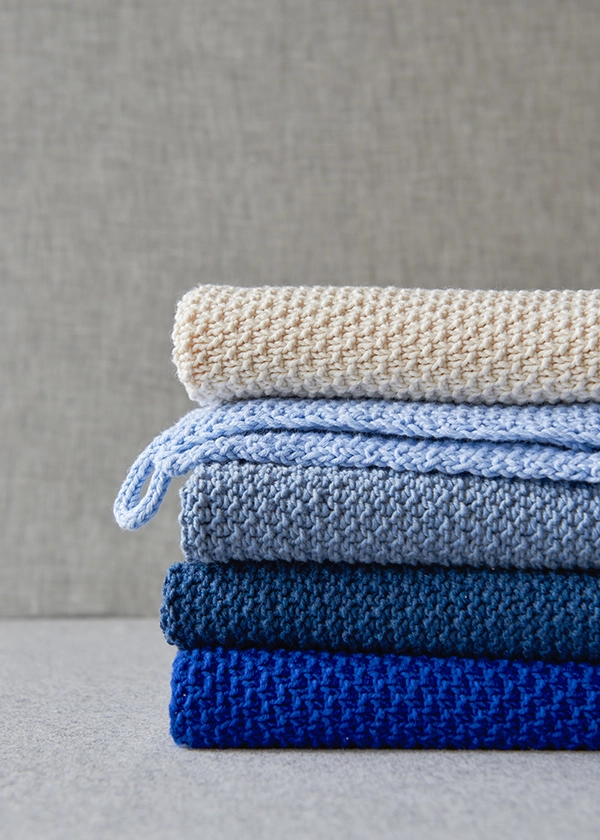
It all begins the moment you cast on because the very process of knitting these little gems with your own two hands brings on tingles of accomplishment and pride, the kind of satisfaction that no other dishtowel could possibly bring.
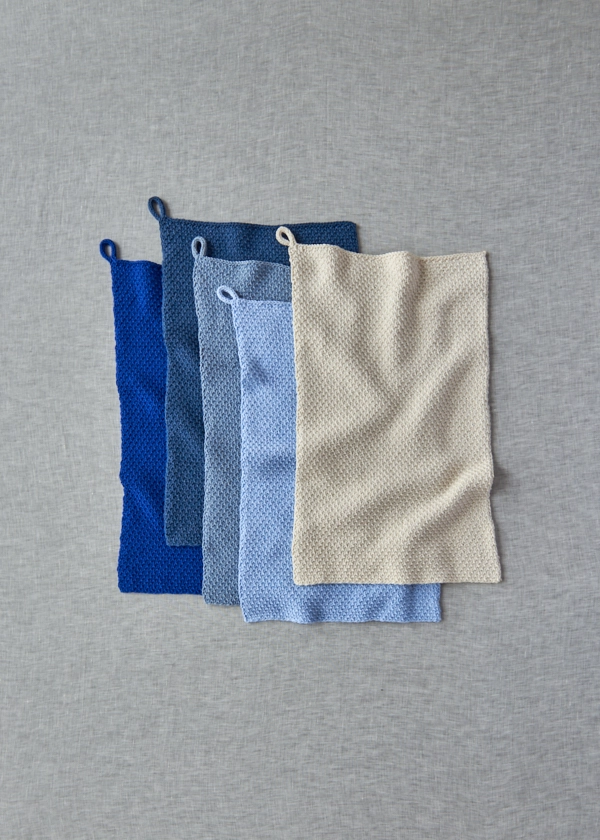
Besides having been made you, what makes this particular dishtowel so lovable is its all-over nubbly rose-stitch texture. A basic seed stitch with a literal twist on the knit stitches of every other row, the result is dual-sided beauty with a bit of scrubbing power.
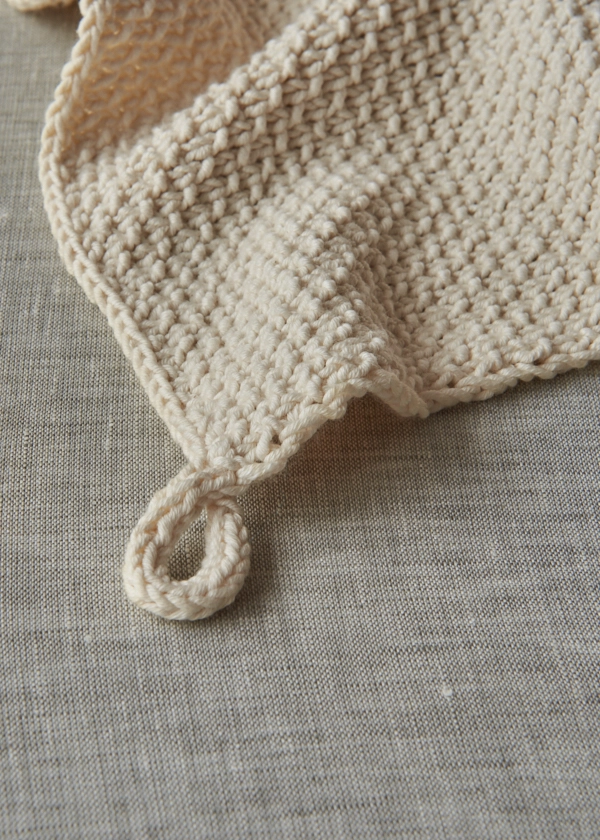
All this in our perfectly lovely Cotton Pure. One hundred percent organically grown cotton and just one skein for one dishtowel… No time like the present!
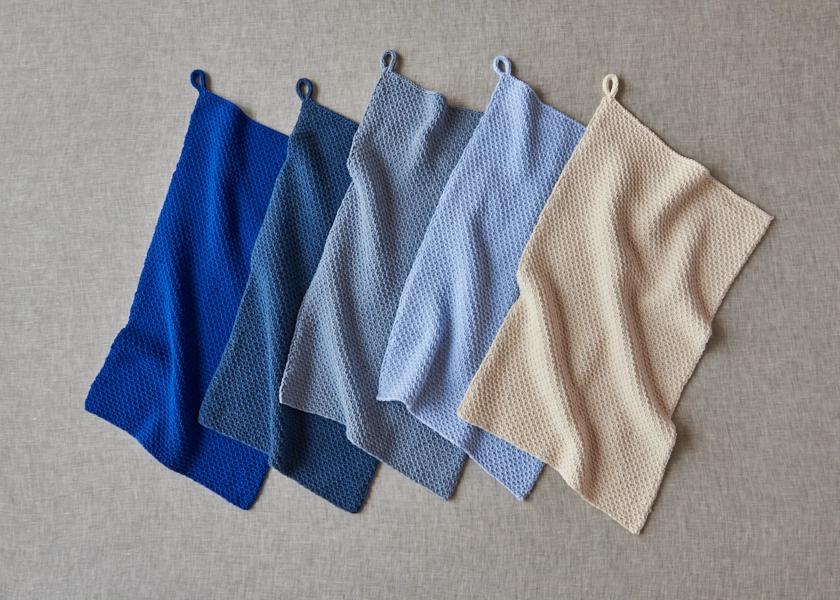
UPDATE: IN MORE BEAUTIFUL COTTON PURE COLORS
JULY 2022
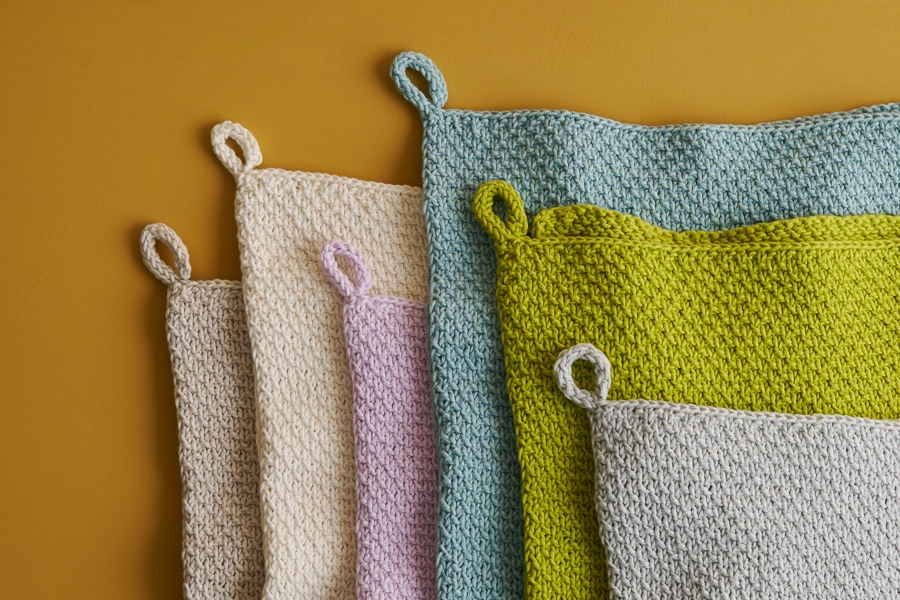
With over two dozen colors available, Cotton Pure has a palette as bountiful as a ripening garden. We love how punchy Lemon Mint brightens this set of Rose Stitch Dishtowels in dreamy, soft colors and down-to-earth neutrals… Gorgeous! Get your creative juices flowing and craft the right combo for you, whether it’s full of peaceful pigments or a vibrant variety!
Designed by Purl Soho designer, Jake Canton. Click here to see even more of Jake’s designs!
Share your progress + connect with the community by tagging your pics with #PurlSoho, #PurlSohoBusyHands, #PurlSohoRoseStitchDishtowel, and #PurlSohoCottonPure. We can’t wait to see what you make!
Materials
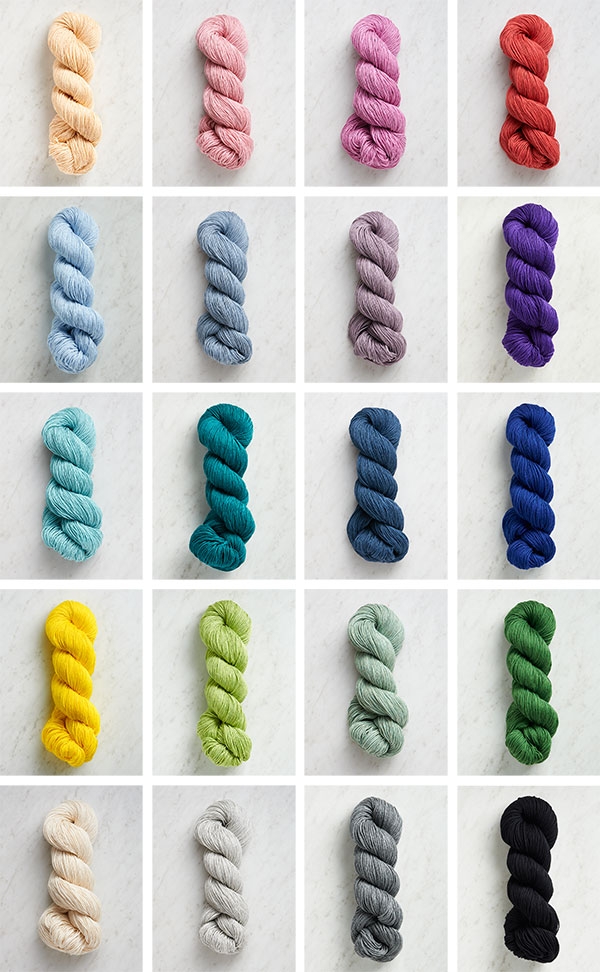
- 1 skein of Purl Soho’s Cotton Pure, 100% organically grown cotton. Each skein is 279 yards; approximately 279 yards required.
- US 4 (3.5 mm) straight or circular needles
- If using straight needles: Two US 4 double pointed needles for I-Cord
SAMPLES: We knit our samples in the colors Heirloom White, Moonflower Blue, Waterdrop Blue, Blue Gale, and Ultramarine Blue.
Gauge
22 stitches and 40 rows = 4 inches in stitch pattern
Size
Finished Dimensions: Approximately 12 inches wide x 20 inches long
Note
Stitch Multiple
This stitch pattern works over an odd multiple of stitches.
Slip Stitches
Slip all slipped stitches knitwise with yarn in front.
Pattern
Cast on 65 stitches. We used a basic Long Tail Cast On.
Row 1 (wrong side): Slip 1 (see Notes), *k1, p1, repeat from * to last 2 stitches, k2.
Row 2 (right side): Slip 1, *k1 through the back loop (tbl), k1, repeat from * to end of row.
Row 3: Slip 1, *p1, k1, repeat from * to end of row.
Row 4: Slip 1, *k1, k1 tbl, repeat from * to last 2 stitches, k2.
Repeat Rows 1-4 until piece measures 20 inches from cast-on edge or until desired length, ending with Row 1.
Bind-Off Row (right side): Bind off knitwise to last 2 stitches, k2, leaving 3 stitches on right needle.
Make I-Cord
With the remaining 3 stitches, work an I-Cord for 3 inches, working the last row as follows…
Last Row: K1, k2tog, pass first stitch over second stitch and off the right needle. Cut yarn, leaving an 8-inch tail and pull through remaining stitch.
Thread the tail onto a tapestry needle. Make a loop with the I-cord and weave the tail into the fabric of the dishtowel at the base of the I-cord, then weave it through the looped I-cord, and back into the fabric of the dishtowel.
Weave in the ends, wet block, and done!
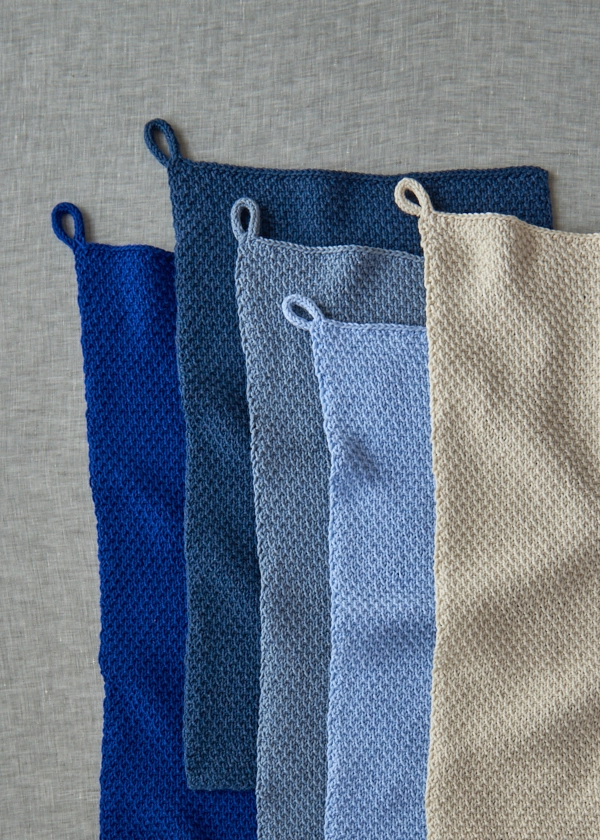

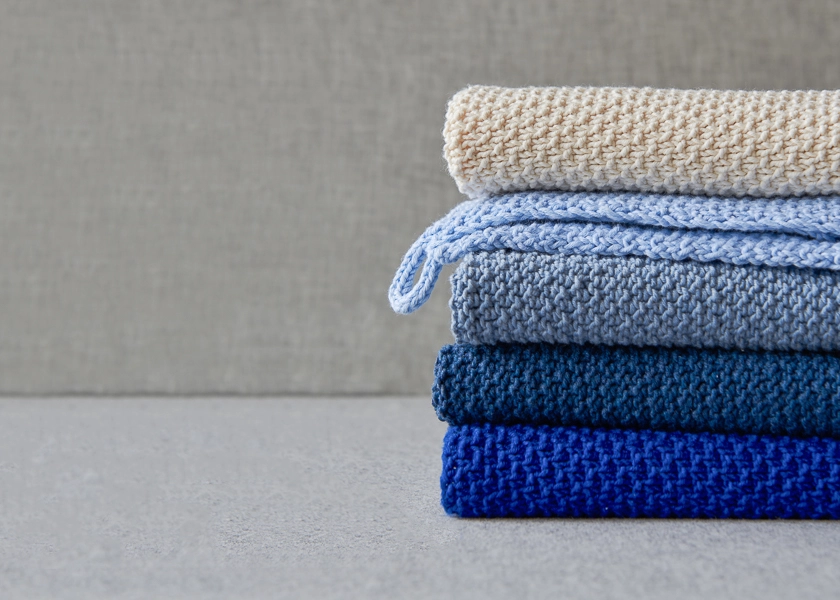
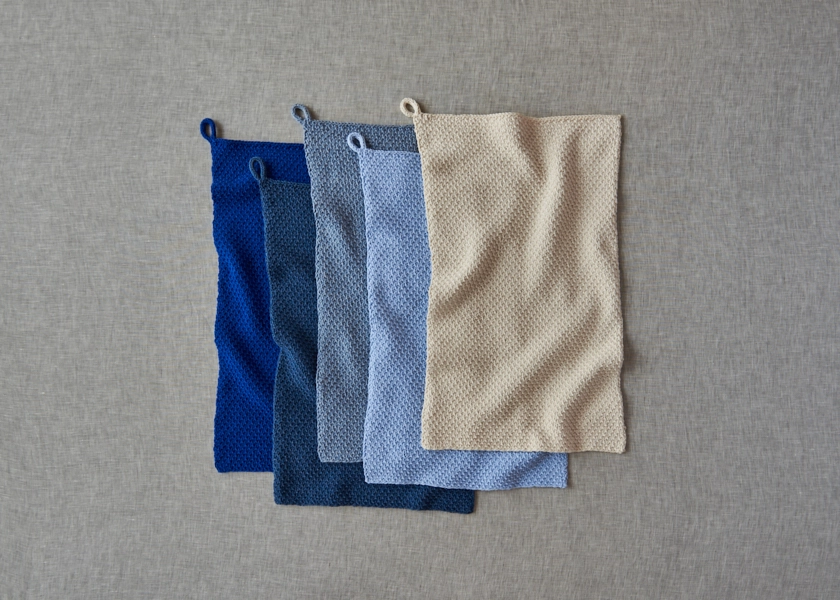
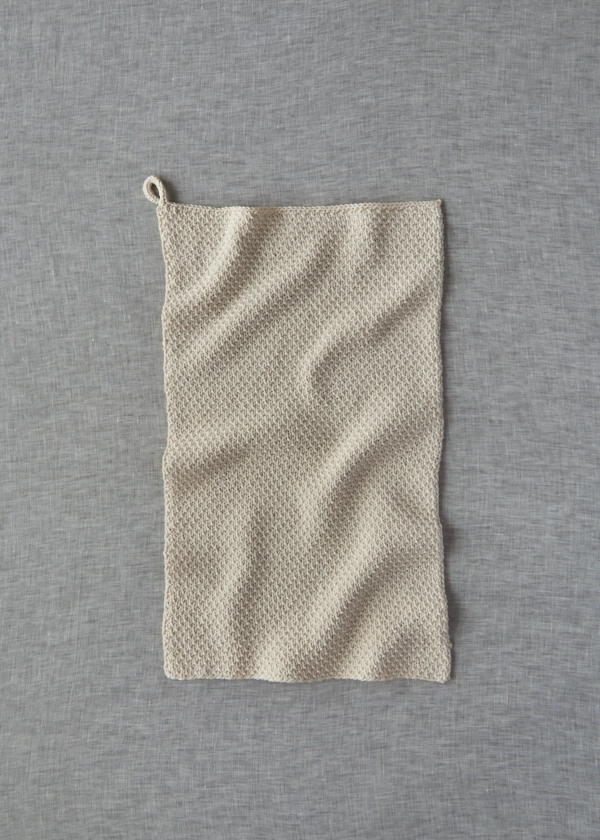
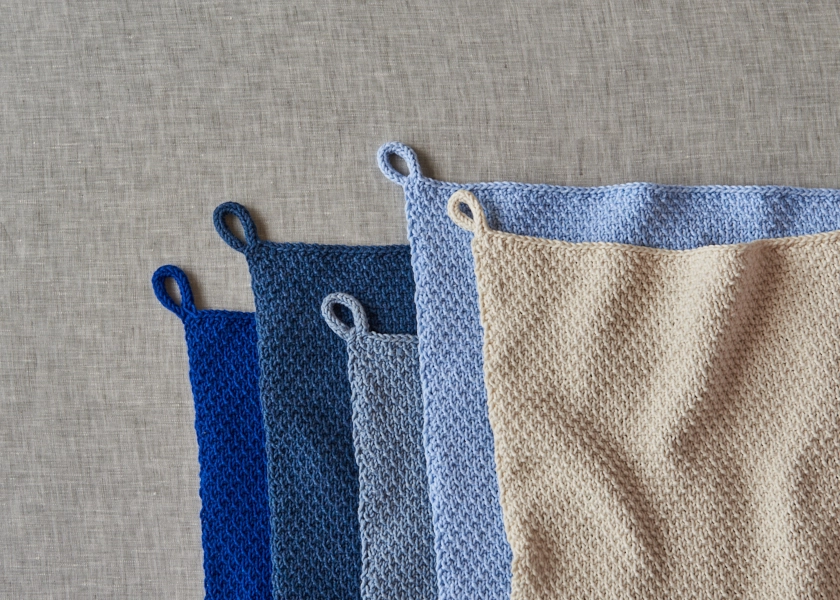
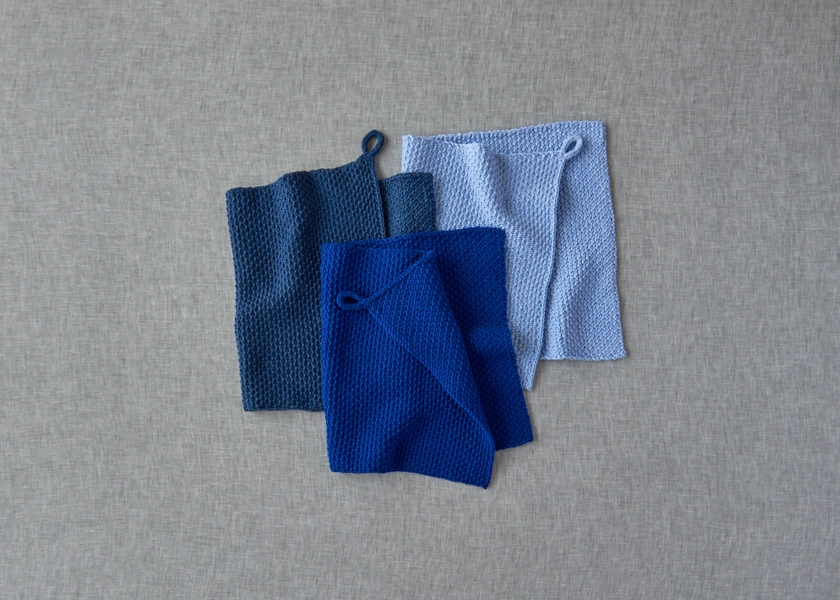
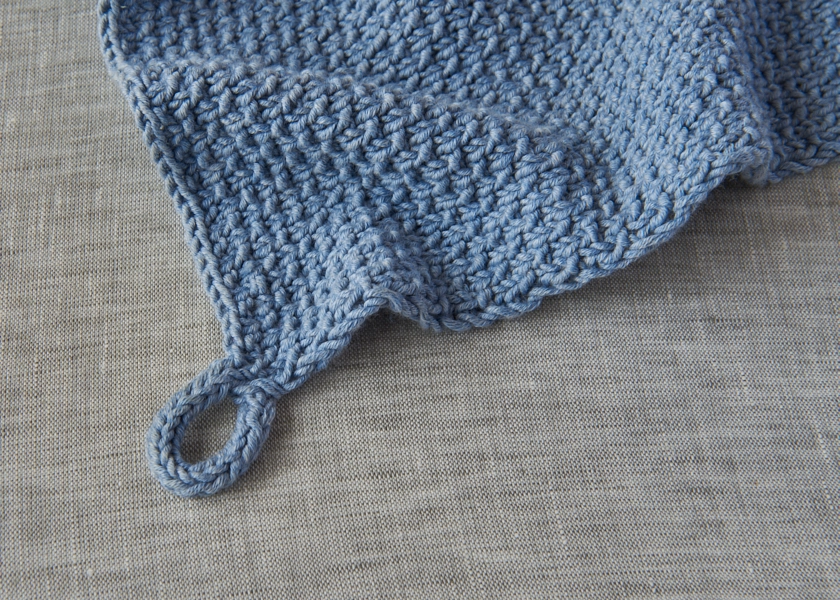



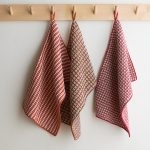


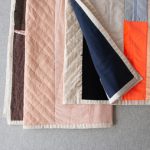

This is lovely. I would love instructions for matching dishcloths!
Hi Olivia
Thanks for writing in! We love this pattern too! These are very easily adjusted to the size you want. The gauge for this pattern is 22 stitches per 4″, (5.5 sts per inch) so if you would like a 7″ wide dishcloth, you would need to cast on around 39 stitches. Just make sure you cast on an odd number, and then knit to the length you prefer. I hope this helps!
Happy knitting
Jessica
This is a sweet little pattern, but I was confused about one piece of the directions:
“Bind-Off Row (right side): Bind off knitwise to last 2 stitches, k2, leaving 3 stitches on right needle.”
Should this read “Bind-Off Row (right side): Bind off knitwise to last five (not two) stitches, k2, leaving 3 stitches on right needle”?
I am probably misreading this line, but maybe you can clarify this part.
Many thanks for your help! Ridie
Hi Ridie
That’s a great question! After each stitch you bind off, you will always have one stitch remaining on the right needle. In this row you bind off to the last 2 stitches (still on the left needle), the 3rd stitch will already be on the right. You will knit the last 2 stitches and all 3 will now be on the right needle.
I hope this helps!
Happy knitting
Jessica
Can this be done in crocheting? And as a blanket?
Hi Carol
Thanks for the question! We don’t have this exact stitch in crochet, but the Stacked Coins Blanket would be a great choice for a similar look, and feel. The Crocheted Super Easy Baby Blanket could also be enlarged to work. This would require a gauge swatch, and figuring out your single crochets per inch, and multiplying that by the desired width of your blanket, to determine the amount to start with. I hope this helps!
Warmly
Jessica
Carol, for a similar crochet version of this, use the lemon peel stitch and just make it as big as you desire. It is my favorite crochet texture stitch for scrubby clothes of all types. If you google it, you can find video or written tutorials.
Will 100% Linen work for this?
Hi Gina
Thanks for writing in! This pattern would be beautiful in linen as well! Field Linen would be a great choice. I would recommend doing a gauge swatch to see if you need to adjust your needle size, and possibly your cast on number. If you need to add stitches, just make sure your cast on number is odd. I hope this helps and happy knitting!
Jessica
Would you do a video of what knitting one in the back loop looks like?
Hi Maureen
Thanks for reaching out! We, unfortunately, don’t have a specific video for knitting in the back loop, but if you watch Knit Front and Back tutorial and skip the step of knitting into the front stitch, and just knit into the back of the stitch this would be correct. I hope this helps you!
Best
Jessica
Love the stitch! Will try this one soon.
I’m just wondering why this pattern specifies a long-tail cast on. As far as I can tell, a long-tail cast on is the same stitch as a regular knitted cast-on, except you end up with the tail at the beginning instead of the end of the first row. This specification isn’t unique to this pattern, of course, so your education will be appreciated for many years! Thanks!
Hi Sharon,
Great question! We use and recommend a Long Tail Cast On for many of our patterns because it is a fantastic all-purpose cast on that creates an attractive, moderately elastic edge. For patterns that don’t require a stretchy edge, like this dishtowel, you could substitute a Cable Cast On which has the advantage of not having to estimate how much yarn you will need ahead of time. Although the Cable Cast On isn’t as elastic as a Long Tail Cast On, both methods create a very tidy edge. A knit cast on is similar to a cable cast on, but it results in a much looser, less stable edge that often has a loopy appearance. If you are up for learning something new, I would recommend trying out either the Long Tail or Cable Cast On for your next project, or possibly working a few swatches with each, so you can see how the different techniques affect the edge of your work!
I hope that helps, and happy knitting!
Julianna
Great pattern! I am wondering if it would be necessary to wash these separately and hang them dry to guard to the color or if they can stand up to regular washings and the dryer. Any advice about the Cotton Pure yarn and washing/care is welcome. Thank you!
Hi Judy,
Great question! Cotton Pure is a very durable, color-fast yarn that washes and dries beautifully! I can attest to this personally, as I made a striped child’s vest several years ago that has made countless trips through the washer and dryer and still looks just as good as new. You can safely throw your dishtowels in with any cold water load of laundry!
Happy knitting!
Julianna
Is it possible to use linen instead of the cotton with this pattern or not recommended.
Thanks!
Jean
I want to make a dishcloth but am torn between this pattern and the Slip Stitch dishtowel. How do you think this pattern would look with strips like you did with the Farmhouse dishtowel. Do you think the cotton pure or the linen is more absorbent for a dishtowel, could I do the Slip Stitch in cotton pure?
Hi Mary
Thanks for the great questions! Both are great patterns for dishtowels! We do have a version of the Slip Stitch Dishtowel in Cotton Pure . Linen is slightly more absorbent than cotton, but both are used in many of our dishtowel patterns, and no one has tried adding stripes yet, but I think it would be a fun addition! The slipped stitch dishtowel is really great at showcasing the contrast of 2 colors. I probably didn’t make this decision any easier, because I would knit both!
Happy knitting
Jessica
Great pattern! I will make this. It is a good gift.
Thank you very much
Ana
Hi Jean,
Great question! Linen also makes for beautiful, absorbent, and durable dishtowels, so I think it would be a great alternative! Our Field Linen would be beautiful for these dishtowels, but it is a little thinner than Cotton Pure, so I would recommend knitting a gauge swatch on a US 3 or 4 to determine if you will need to adjust how many stitches to cast on.
Happy knitting!
Julianna
Hello I recently purchased this Cotton for the farmhouse dish towel. I loved the feel of the Cotton and it worked up beautifully. I am very interested in ordering other colors but I found this yarn hard to wind at home . Are your winding services available yet?
Hi Debbie,
Thank you so much for the kind words – it’s wonderful to hear that you enjoyed knitting with Cotton Pure so much! Unfortunately, we still do not have enough staff to wind orders before shipping. We are hopeful that we can return to normal staffing levels soon, but we do not have an estimated date. I’m so sorry for the inconvenience! I find it very helpful to place the skein over the back of a chair or two chairs so it stays open and untangled while I am winding, and if you find it hard to get started, you can always create a core for your ball of yarn by winding onto a few balled up paper towels or an empty paper towel or toilet paper roll.
I hope that helps, and happy knitting!
Julianna
Good Afternoon,
do you recommend this stitch for blanket using a baby alpaca yarn ?
Thank you very much,
Kind regards,
Marcella
Hi Marcella
Thanks for writing in! This stitch would be really beautiful for a blanket! As always, when substituting a different yarn, it is a very good idea to first knit a gauge swatch in pattern to see if you like it and determine your correct needle size. I hope this helps!
Happy knitting
Jessica
Thank you Jessica,
Couldn’t one use an Icord bind off for this? And then continue on with an Icord for the loop?
Hi Kat
That’s a great question! It will create a slightly thicker edge, but would still look great! If you want to make it super matching on both ends, try the I-cord Cast On tutorial.
Happy knitting!
Jessica
Thank you for this great pattern. I changed the stitch count due to the availability of my yarn and made 2 already. It helped me to calm my anxiety during this week. Thank you.
HI!
Where do I find the notes?
“Row 1 (wrong side): Slip 1 (see Notes)”
Hi Melissa,
Thanks for reaching out! You can find the Notes at the top of the pattern, shortly after grid showing all the colors of Cotton Pure. In this case, the note you are looking for will tell you that all slip stitches should be slipped knitwise with the yarn in front!
Best,
Julianna
Your patterns are well written and give beautiful results, however, I Crochet only. Could you put a “K” or “C” at the very beginning of each article and pattern. First. Even on or above each photo? This would save me lots of reading time. This would let me know if I need to read the details or simply enjoy the photo. Thanks.
Hi Tracy,
Thanks for writing in! I will certainly pass your suggestion along to the design team! You can always view just our crochet patterns by hovering over “Create” at the top left corner of our website, and then clicking “Crochet.”
I hope that helps!
Julianna
Would a video of this pattern be possible to post? I’m confused about slipping the first stitch of every row and when to move the yarn from front to back and vice versa. Thank you for making so many of your beautiful patterns available for free!
Hi Janet,
Thanks for writing in! Unfortunately, we don’t currently have the resources to create a video for this technique. I will, however, be sure to pass your request along to the design team!
Best,
Julianna
Hi – I have started to knit this Rose Stitch Dishtowel. I have a question about the slip stitch. So, it says slip all slip stitches knit wise with the yarn in front. I am a little confused with this. I did find something I had printed How to Slip Stitches. Is this what I am supposed to do when I slip the first stitch? I don’t see how this is a slipped stitch…it says to pull the working yarn through the stitch. Isn’t this just a knitted stitch? Thank you for your help. Barbara
Hi Barbara
Thanks for writing in! You will only be slipping the first stitch of every row of this pattern to create a decorative edge. To slip this first stitch, take your working yarn and move it to the front of your work, take your right needle and insert the tip through the first stitch as if you were going to knit and slide the stitch to the right needle completely. You will then take your working yarn between the needles to the back of your work to knit for rows 1,2 & 4. For row 3 your yarn will be in front and ready to purl the next stitch. When slipping stitches in any pattern, it usually means to transfer from the left needle to the right needle with out knitting or purling the stitch. Where you hold your yarn, wyif (with yarn in front) or wyib (with yarn in back) should be specified at the beginning of the pattern in the instructions. I hope this helps!
Happy knitting
Jessica
Hi Jessica, thank you so much! I get it now. ??
Is this project considered a quick one i.e will this stitch be easy to relax with and go quickly ?
Thank you!
Amy
Hi Amy,
Having knit these myself, I can indeed say this stitch is easy to memorize and makes for a relaxing knit. They knit up surprisingly quickly! Enjoy!
Kindly,
Anna
purlsoho.com
hi! is this appropriate for a first-time beginner project?
Hi Elizabeth,
Thanks for reaching out! I think this could be a doable project for a beginner, there are a few more slightly advanced techniques but we have many excellent tutorials and you can always reach out with any questions you may have along the way!
Also, I saw your other comment! We recently updated out site and have been experiencing some residual glitches we are still trying to iron out! Thank you for bringing this to our attention and we will hopefully get all the comments back as soon as possible!
Happy knitting!
Gianna
I have made two of these towels but at washcloth size. The pattern is a bit tricky at first. I found that just writing down the directions for the four rows on a piece of paper and just keeping that beside me, and using a clip-on marker for the start of each row got me over the hump of learning this pattern. I used the recommended cotton. These are my favorite washcloths for sure!
Hi Linda,
We’re so glad to hear that you’re enjoying the pattern! I love the idea of these as a smaller washcloth. Thank you for sharing, and for your kind words!
Warmly,
Kelsey
I love this pattern, and you might want to know that the size will be adjusted slightly to make a blanket for preemies in our local Hospital NICU 🙂 The little darlings cannot have heavy weights on them, and blankets are only 15″ x 18″ or close to it!
Thanks again,
Julie
Hi! I was wondering how many clothes each skein makes? Can I get two clothes out of one skein? Thanks!
Hi Julie,
Thanks for reaching out! One skein makes one dishtowel, each skein is 279 yards; approximately 279 yards required for one!
I hope this clears things up!
Gianna
I love how this came out! I was worried about the slip stitch selvedge while knitting because it seemed a bit loose, but once wet blocking was done it looked excellent.
One thing of note – I was fortunate enough to have size 4 DPNs for the I-cord, but these were not mentioned in the required materials. It would be sad to make it to the end and need to go out and buy something!
Hi Liz,
Thanks for commenting! We’re so happy to hear that you enjoyed making the Rose Stitch Dishtowel!
I’m glad to share that the pattern story now includes a mention of using DPNs (under the Materials header, it says, ‘If using straight needles: Two US 4 double pointed needles for I-Cord’). Thank you so much for bringing this to our attention!
All the best,
Cat
I love this pattern, and I started my first Rose Stitch Dishtowel yesterday. I have begun to notice that the two edges look a bit wonky as established, but I think I have a simple solution.
My go-to edging is to slip the first stitch of every row knitwise, and then to purl the last stitch of every row. So if I add one edge stitch to the cast-on, my edging should work since the pattern already calls for slipping every first stitch knitwise. Then I would simply purl the last stitch on every row. What do you think?
Hi Vivian,
Thanks for writing in with your question! The first slipped stitch of every row is slipped knit-wise and with the yarn held in front so that when you knit that stitch on a wrong side row, you are creating a neat and sturdy knit edge. If you purl that last stitch instead of knitting it, you will be creating a small purl-ridge at the edge of each row, which will change how the dishtowel looks and may not help to hold the shape of the towel as well when wet.
I hope this helps!
All the best,
Carly
My suggestion adds an extra stitch for use at the end of every row, one which is always to be purled. Then you turn your work, and slip the first stitch on the next row knitwise, a step that is already in the pattern. For years, slipping the first stitch knitwise and purling the last stitch on every row has produced neat edges that resemble chain stitching. If I knit another Rose Stitch Dishtowel I will try this and see what happens.
Hi Vivian,
I’m glad that you have been incorporating your own knitting knowledge into your project, and I understand now what you mean by purling the last stitch and slipping the first stitch, but with the yarn held in back. It’s always exciting to see how fellow crafters customize their knits, and I’m sure yours will turn out beautifully!
Please reach out if you have any questions!
All the best,
Carly
Thanks so much for replying, Carly.
I’ll let you know how my edging turns out once I knit another Rose Stitch dishtowel, or maybe a small swatch in that pattern with my edging. If it works, then the edging will also look nice with the BO and I-cord loop.
Vivian Powell
How much yarn should I save to make the 3 inch I cord at the end? I always like to use as much yarn as possible to make the piece, but I want to make sure I have enough to bind off and make an I cord. (I am using the recommended cotton pure that the pattern calls for)
Also, my slipped stitch edges are curling a bit. I think I am doing it correctly, knit wise w yarn in front….is this curling typical?
Hi Marcia,
Thanks for writing in! I’m afraid that we didn’t keep track of exactly how much yarn it would take to do just the i-cord and bind-off, so figuring that out will take some trial and error, but it is possible. I’d recommend knitting as far as you can and then working the i-cord and bind-off. If you run out of yarn, then you can rip back until you’re at a spot 4 rows prior to where you began these final steps previously. Then, when you continue from there, you will have enough yarn to finish the dishtowel!
In answer to your other question, this stitch pattern may curl a little bit while you’re knitting, but blocking your work afterwards should help minimize that!
All the best,
Lili
Thank you for getting back to me. Of course I have another question!
When the pattern says “ending with row one” does that mean after you’ve finished a row one or ending before you begin a row one? It does say to bind off on right side, and row one is WS, so perhaps I’m binding off on a row two? Please clarify for me.
Thank you!!
Hi Marcia,
That kind of instruction means to end after you’ve completed a Row 1! This will put you in position to bind off on the right side.
All the best,
Lili